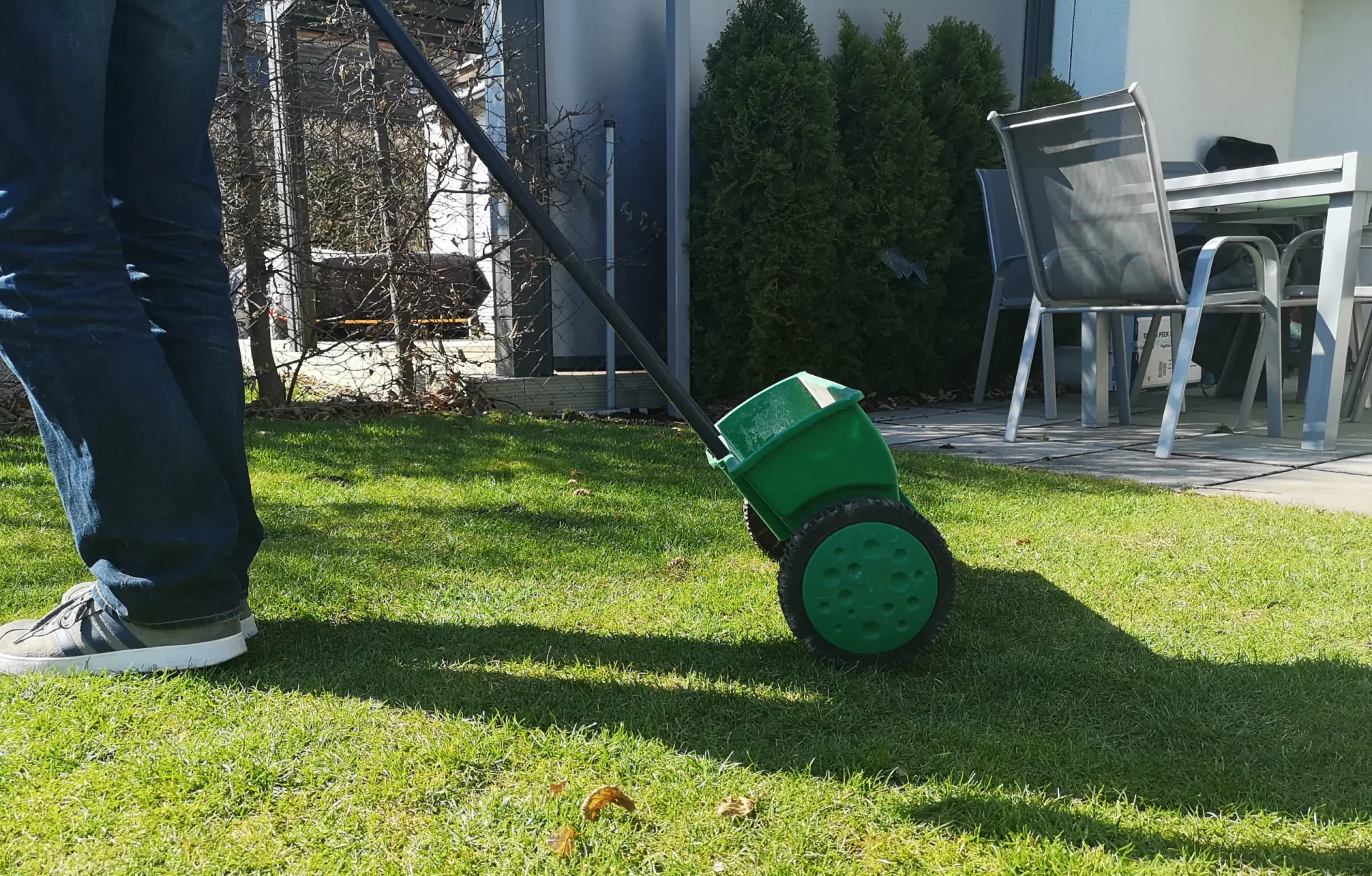In order for your lawn to grow into a beautiful, lush carpet and then remain so beautiful, it must be supplied with nutrients on a regular basis. This article explains what needs to be considered when fertilizing, which different products are available and how to carry out the fertilization correctly.
How often and when should you fertilize?
For a beautiful lawn, it is necessary to fertilize it three to four times a year. Why is fertilizing necessary at all? Because the lawn constantly draws nutrients from the soil and these are permanently removed by mowing and removing the lawn clippings. Rain also washes out the soil. In the course of time, fewer and fewer nutrients from the soil are available to the lawn. You balance that out with fertilizing.
The first fertilization of the year should take place at the end of March/beginning of April. The lawn is exhausted after the winter and the fertilizer helps it start the gardening season. Early fertilization is also important to prevent weeds from spreading before the lawn has strengthened. The fertilization takes place after the first mowing or scarifying. There are also expert opinions on scarifying that recommend fertilizing a few days before scarifying so that the lawn is already strengthened by then and can then recover more quickly from the strain of scarifying. In order for the fertilizer to get into the soil, it must be watered after fertilization. If rain is announced anyway, you can of course also use the natural rain for it.
Complete fertilizer is usually used as lawn fertilizer, i.e. fertilizer that contains all the ingredients necessary for the lawn. The use of additional fertilizer is then not necessary. You would only refrain from using complete fertilizer if you wanted to specifically compensate for individual weaknesses in the lawn after testing them out beforehand.
Fertilization is repeated after the first fertilization at approx. 2 to 3 month intervals. In autumn, by mid-November at the latest, but in any case in good time before frost sets in or before it snows for the first time, the season should end with autumn fertilization.
Difference between autumn fertilizer and spring/summer fertilizer
In autumn you should use a different fertilizer than in spring and summer. The spring and summer fertilizer is rich in nitrogen and thus promotes lawn growth. In autumn, on the other hand, the main focus is on strengthening the lawn and making it resistant for the winter, growth plays only a very small role. Therefore, the fertilizer offered as “autumn fertilizer” contains comparatively little nitrogen, but a relatively large proportion of potassium. Using a nitrogen-rich spring/summer fertilizer in the fall would even be counterproductive, as it encourages new shoots, which would then be particularly susceptible to frost and endangered in winter.
What is lawn fertilizer made of?
Lawn fertilizer basically consists of three basic contents:
- Nitrogen (chemical symbol “N”) -> Promotes lawn growth
- Phosphorus (chemical symbol “P”) -> Strengthens the root system of the lawn
- Potassium (chemical symbol “K”) -> Increases the resilience of the lawn
In addition, smaller amounts of secondary nutrients such as magnesium, iron, calcium, zinc, copper, boron and sulfur can be included, which the lawn only needs in comparatively small amounts.
Some lawn fertilizers are also combined with a weed killer or a moss killer. These additives work, but an even better effect is usually obtained if weed or moss agents are used separately.
A spring or summer fertilizer is typically around 15 to 20% nitrogen, 5% phosphorus, and 8% potassium. With the autumn fertilizer, the ratio is clearly reversed, e.g. in 10% nitrogen, 5% phosphorus and 20% potassium. The 3 basic ingredients of the fertilizer are always given in the same order in sales offers. If a fertilizer is described as 15-5-8, that means 15% nitrogen, 5% phosphorus and 8% potassium.
Three types of fertilizer
A distinction is made between three types of fertilizer:
- Organic fertilizer: Consists of naturally occurring plant or animal waste products, e.g. horn shavings, chicken droppings or stinging nettles. The fertilizer does not act on the lawn immediately after application, but only gradually when microorganisms begin to break down the fertilizer. In return, the effect lasts for a long time.
- Mineral fertilizer: Is fertilizer that is not obtained from living (organic) substances, but that is synthetically produced in the factory. The name mineral fertilizer comes from the fact that the necessary raw materials are largely obtained in mining. The fertilizer unfolds its effect very quickly and strongly.
- Organic-mineral fertilizer: Is a cross between the two fertilizers. An organic fertilizer that is additionally mixed with mineral nutrients.
Mineral fertilizer
Advantages of mineral fertilizers:
Disadvantages of mineral fertilizers:
Organic Fertilizer
Advantages of organic fertilizers:
Disadvantages of organic fertilizers:
Long-term fertilizer
Organic fertilizer is – as explained above – a natural long-term fertilizer. It needs time to gradually unfold its effect. In principle, this would not be the case with mineral fertilizers, which would take full effect immediately, but on the other hand would lose their effect relatively quickly. So that this is not the case, long-term fertilizers are offered. In these, the fertilizer or part of the fertilizer is coated with a natural material such as resin, which only gradually dissolves and releases the fertilizer. This ensures that the effect unfolds gradually and lasts much longer, up to 3 months. An alternative way to achieve this effect is to add inhibitors, which also cause the effects to develop more slowly.
Personal experience
As you can see from the above, both organic and mineral fertilizers have their pros and cons. My personal experiences with it are as follows:
The mineral fertilizer works very quickly, the result can be seen just a few days after fertilization. The lawn gets a beautiful deep green color and grows vigorously. The first two weeks after fertilization you have twice or even more cuttings when mowing the lawn. Damage or unsightly spots after the winter can be repaired quite quickly. On the other hand, the effect wears off relatively quickly after 2 to 3 weeks. In my experience so far, this also applies to the products sold as long-term fertilizers. The promised 3 months are illusory in practice. So you have a nice effect very quickly, but unfortunately it doesn’t last as long as you would like. In addition, you have to be careful when fertilizing, since areas that get too much fertilizer burn very quickly and become bare. In practice, this is not so easy to avoid, since, for example, something can go wrong when filling the spreader. Fertilizer that gets onto the floor slab and is not removed immediately can also cause slight stains, which in my experience disappear again over time.
Organic fertilizer, on the other hand, takes a long time to develop an initial effect. You can sometimes have doubts as to whether anything is happening at all. And the effect is in any case less strong than with mineral fertilizers. This is also noticeable when cutting the lawn, which is only slightly more extensive than usual. In return, the lawn benefits from the fertilizer for a long time, three months are quite realistic. The good environmental conscience is paid for with relatively little visible effect, but it lasts longer. At least that’s my experience so far, maybe there are now more effective products that I’m not yet familiar with.
I myself have now ended up with organic-mineral fertilizers. So with organic fertilizer, which also has a part of mineral fertilizer added. So you have both the long-term effect and the short-term strong effect. Since the nutrient concentration is far less than with purely mineral fertilizers, I think this is a sensible middle ground for the environment too.
Application of the fertilizer
It is fertilized on mowed and dry lawn. The lawn is properly watered only after fertilization has taken place. Some experienced gardeners manage to distribute the fertilizer evenly by hand, but for most – myself included – this is an impossibility.
In this case, a fertilizer wagon or spreader can help. These vehicles can be bought or rented. Since the cheapest ones only cost about 20 to 30 USD and you usually need them several times a year, buying them is usually the more sensible option. The function is quickly explained: The fertilizer is filled into the wagon, the capacity is usually around 3 to 4 gallons. The width of the wagon determines the spreading distance and thus also has an influence on how many lanes you have to pull on the lawn.
The spreader has a grid-shaped opening in the lower area, the mesh size of which can be reduced or increased using a lever or rotary knob. In most cases, the mesh size can be adjusted in steps. Which level you need depends on the size of the individual fertilizer pellets and how quickly you want to apply the fertilizer. On the packaging of the purchased fertilizer you will usually find information on the appropriate setting.
Carrying out a soil analysis
In order to provide the lawn with the required nutrients in a more targeted manner or to eliminate existing deficiencies or oversupply, it can make sense to carry out a soil analysis. The same applies, of course, if, despite all efforts and care, the lawn or plants do not thrive as desired. The soil analysis shows you the ratio of nutrients and trace elements in the soil and the pH value. This helps to fertilize exactly what the soil needs. Such an analysis can be carried out before a new lawn is laid or in the case of existing areas, in order to check again and again at intervals of around 2 to 3 years that everything is still in balance.
Professional soil analyzes are now also offered by several providers for private users. A specified number of soil samples are taken from a number of locations in the garden at a depth specified by the laboratory (6 to 12 inches) and sent to the laboratory. This always happens for a contiguous garden area. For example, if you want to have your lawn and vegetable patch examined, these are two different jobs that shouldn’t be mixed up.
The laboratory examines the sample for specified properties and sends you the test result together with a concrete fertilizer recommendation based on it. In some cases, an additional humus analysis can also be ordered, which is particularly relevant for kitchen gardens. Depending on the scope of services, prices start at around 40 USD. In some offers, a practical set for taking samples is already included in the price, so that you don’t have to worry about anything: Simply take samples with the tool provided, fill them into the container provided and send them to the laboratory. After a few days, you will receive the result of the analysis by mail.


